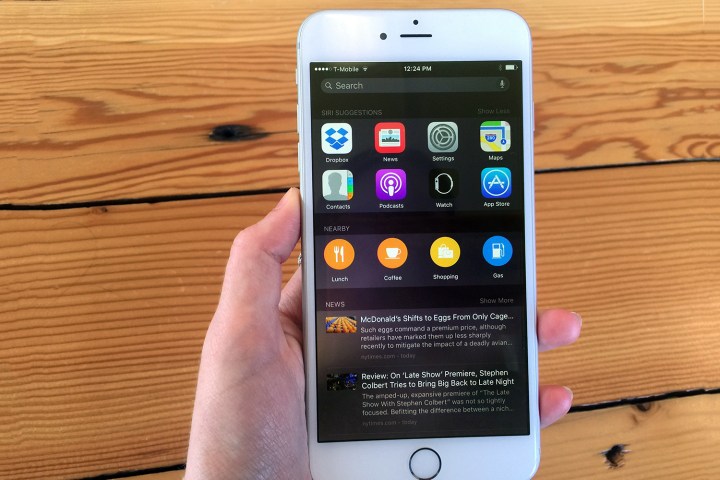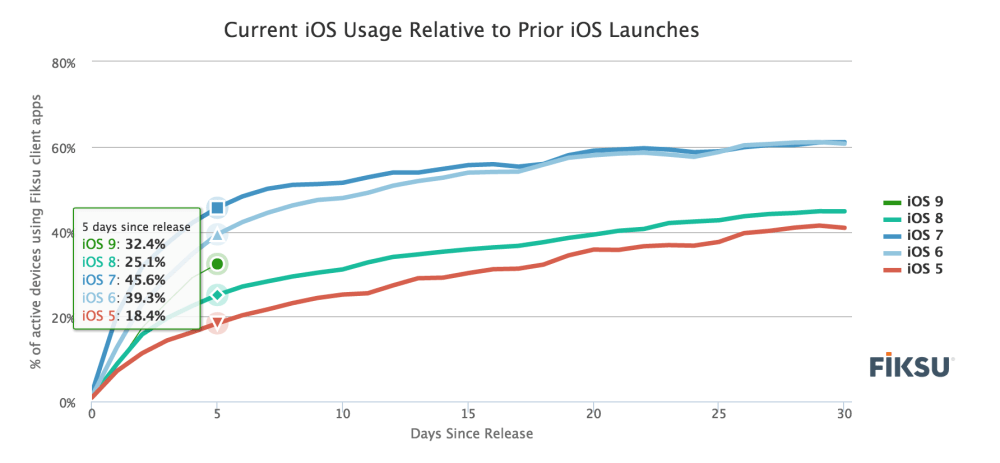
That is an impressive number, but compared to data from other intelligence firms like Fiksu and Crittercism, it looks like Apple is shooting a little high. Both iOS adoption rate trackers give an estimate of between 30 and 35 percent adoption rate by five days. Fiksu even offers a real-time iOS Launch Comparison, currently estimating a 32.4 percent adoption rate.
On the first 24 hours, mobile analytics firm Mixpanel revealed that only 11 percent of users updated to iOS 9 in the first 24 hours. That was a drop of three percent over last year’s figures for iOS 8, and five percent lower than rates for iOS 7. We considered that users were cautious after the failures of iOS 8, but even more have jumped the gun in the past four days, despite the botched iOS 8 launch.
The iOS adoption rate is much higher than Windows or Android adoption rates, and 32 percent amounts to hundreds of millions of iPhone and iPad users. All of Apple’s most popular devices are compatible with iOS 9, so it takes less time for users to upgrade to the new version of iOS than it does their Android and Windows counterparts. For Google and Microsoft, it is a challenge trying to get manufacturers to push the updates to devices on time, so the delay is understandable, albeit irritating.
Mobile intelligence group Crittercism rightly predicted that iOS 9 would reach 50 percent quicker than iOS 8, thanks to a lower crash rate. The platform found crash rates on iOS 9 were one percent lower than iOS 8, leading to more consumer confidence in iOS 9.
Apple’s iOS 9 did suffer from server issues in the first hours, with plenty of users receiving a ‘Software Update Failed’ message when trying to download the update. Not all users were affected, and Apple fixed the issue a few hours after launch. This could be the major reason why, in the first 24 hours, iOS 8 performed better than iOS 9.
iOS 9 brings a load of new features to the smartphone and tablet, including a new search panel, updated Siri, transit maps, multi-tasking features for iPad, improved security, and more battery life. News, Wallet, iCloud Drive, updated Notes, and an updated keyboard all come in the new OS as well. However, Apple has lowered the size of the over-the-air update by three quarters.
There is still anger amongst iPhone and iPad users that they cannot remove permanent apps, but Apple’s CEO Tim Cook said he was open to the idea of removing some apps that aren’t connected to other services inside iOS. The ability to remove pre-installed apps will not be available on iOS 9, however.
Updated on 09-21-2015 by David Curry: Added in new information from Fiksu and Apple on iOS 9 adoption rate after five days.
Editors' Recommendations
- This one Apple Fitness feature completely changed how I exercise
- We finally know when Apple will announce its 2024 iPads
- An Apple insider just revealed how iOS 18’s AI features will work
- There’s a big problem with the iPhone’s Photos app
- Apple accidentally revealed a big iPad Pro display upgrade




